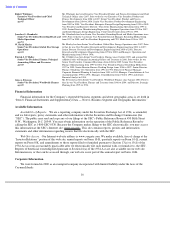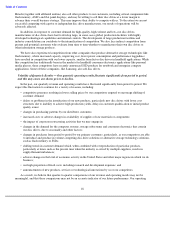Seagate 2006 Annual Report Download - page 22
Download and view the complete annual report
Please find page 22 of the 2006 Seagate annual report below. You can navigate through the pages in the report by either clicking on the pages listed below, or by using the keyword search tool below to find specific information within the annual report.
Table of Contents
results in one or more future quarters may fail to meet the expectations of investment research analysts or investors,
which could cause an immediate and significant decline in the trading price of our common shares.
New Product Offerings —
Market acceptance of new product introductions cannot be accurately predicted, and
our results of operations will suffer if there is less demand for our new products than is anticipated.
We are continually developing new products with the goal that we will be able to introduce technologically
advanced and lower cost disc drives into the marketplace ahead of our competitors. We are particularly depending on
the successful introduction, qualification and volume sales of new lower cost products for our results in the next few
quarters.
The success of our new product introductions is dependent on a number of factors, including market acceptance,
our ability to manage the risks associated with product transitions, the effective management of inventory levels in
line with anticipated product demand, and the risk that our new products will have quality problems or other defects
in the early stages of introduction that were not anticipated in the design of those products. Accordingly, we cannot
accurately determine the ultimate effect that our new products will have on our results of operations.
In addition, the success of our new product introductions is dependent upon our ability to qualify as a primary
source of supply with our OEM customers. In order for our products to be considered by our customers for
qualification, we must be among the leaders in time-to-market with those new products. Once a product is accepted
for qualification testing, any failure or delay in the qualification process or a requirement that we requalify can result
in our losing sales to that customer until new products are introduced. The limited number of high-volume OEMs
magnifies the effect of missing a product qualification opportunity. These risks are further magnified because we
expect competitive pressures to result in declining sales and declining gross margins on our current generation
products. We cannot assure you that we will be among the leaders in time-to-market with new products or that we
will be able to successfully qualify new products with our customers in the future.
Smaller Form Factor Disc Drives — If we do not continue to successfully market smaller form factor disc
drives, our business may suffer.
The disc drive industry is experiencing significant increases in sales of smaller form factor disc drives for an
expanding number of applications, in particular notebook computers and consumer electronics devices, but also
including personal computers and enterprise storage applications. Much of our recent revenue growth is derived from
the sale of drives for small form factor drives for notebook and enterprise applications.
We have experienced competition from other companies that produce alternative storage technologies like flash
memory, where increased capacity, improving cost, lower power consumption and performance ruggedness have
resulted in competition with our lower capacity, smaller form factor disc drives in handheld applications. This
competition has largely replaced disc drive products smaller than 1.8-inch with flash memory. However, we believe
that disc drives continue to be well suited in applications requiring capacities of 20 gigabytes or more and that the
demand for additional storage to store, hold or back up related media content from such handheld devices using flash
memory, continues to grow. While this competition has traditionally been in the markets for handheld consumer
electronics applications like digital music players and personal media players, these competitors are also attempting
to introduce SSD products for notebook and enterprise compute applications.
If we do not suitably adapt our product offerings to successfully introduce additional smaller form factor disc
drives or alternative storage products based on flash storage technology, or if flash competitors are successful in
achieving customer acceptance of SSD products for notebook and enterprise compute applications, customers may
decrease the amounts of our products that they purchase which would adversely affect our results of operations.
19
























